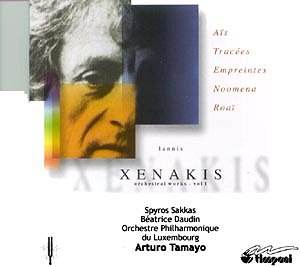XENAKIS
Aïs; Tracées; Empreintes;Noomena;Roáï
Spyros Sakkas (baritone) Beatrice Daudin (percussion)
Orchestre Philharmonique du Luxembourg/Arturo Tamayo
Timpani 1C1057 [59 mins]
Amazon US

"- - - a personality which gives the latter half of the 20th century a
vision of the new millennium, fits a new era more naturally than it does
the old - - -" (Nouritza Matossian, author of Iannis Xenakis - Kahn &
Averill, UK).
Now towards the end of his prolific creative life, this first volume of a
projected series of the Xenakis orchestral works was recorded in Spring 2000
at the marvellous new concert hall at Luxembourg Conservatoire, where the
BBC Symphony Orchestra and Ensemble Contemporain were heard by S&H
during the
ISCM
World Music Days.
The Luxembourg orchestra, over 100 strong for some of these scores, is a
fine one, and Xenakis is done proud here by Arturo Tamayo, long closely
associated with the composer, and by the engineering of this vivid and exciting
music, which has lost none of its power to astonish.
Each piece is an intense, possibly draining, experience so they should not
be listened to straight through. Ais (1980) has a huge orchestra and
percussion solo to support the amplified baritone in a setting of fragments
from the Odyssey, Sapho and the Iliad, with the orchestra of 96 invoking
the inaccessibility of the dead and the dead to be. Spyros Sakkas is a unique
singer, heard in Xenakis's Oresteia in London & on CD
Salabert Actuels
SCD8906, employing here extremes of vocalisation from highest
falsetto to very low recitation - normal middle register singing only rarely.
Hearing him sing music by Xenakis specially composed for him is an eerie,
unforgettable experience.
Empreintes (1975) combines a perspective of a vast panorama with a
quasi-industrial process, 'a sublime acoustic analogue of how our eye
accomplishes a sense of motion when we watch a film' (Matossian & Gehlhaar).
Noomena (1974) has 103 musicians, without percussion, to trace a complex
thread of sound rapidly transforming itself. Tracées (1987)
is a relentless sequence of colliding events of characteristic energy and
complexity. Roáï (1991) dissects and reassembles sound
masses with high strings and brass predominating.
The illustrated booklet has three separate texts in respectively French (Harry
Halbreich), German (Rudolf Frisius) and English (Nouritza Matossian &
Rolf Gehlhaar); for linguists a generous source of background information
. Unreservedly recommended.
Peter Grahame Woolf


